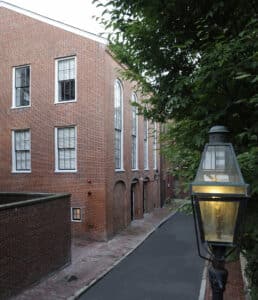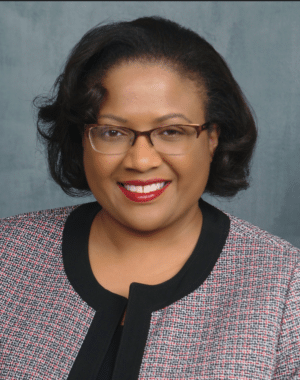Dr. Noelle Trent
CEO, Museum of African American History
Age: 44
Industry experience: 20 years
The next two years include significant milestones for the Museum of African American History, as its Boston campus nears its 230th anniversary in 2026. The Beacon Hill properties include America’s first public school for Black students and the nation’s first Black church, and overseeing preventive maintenance is a key priority for CEO Noelle Trent, who joined the organization in 2023 after eight years as a director of the National Civil Rights Museum’s interpretation, collections and education. The museum also owns an African Meeting House and historic home on Nantucket which will celebrate its bicentennial in 2025.
Q: What are the highlights of your first 10 months in the new Boston position?
A: The community has been very welcoming and that has been pretty significant. In general, the one thing that I really enjoy about the work is the story we tell, the history and the buildings themselves. We have one building that dates back to 1774, and another to 1805. We have about 3,000 objects in our collection. Right now on display we have a bust of Robert Gould Shaw which was created by the sculptor Edmonia Lewis – you don’t find her pieces everywhere, so that’s just phenomenal. We recently acquired some interesting objects from early school desegregation cases, including [the 1849 decision in] (BEG ITALICS)Roberts vs. the City of Boston(END ITALICS).
Q: What has the board of directors indicated are their top priorities?
A: We really work collaboratively on the strategic vision. One of the things I’m really focused on is sustaining the museum for the next 100 years. That and also looking at how we expand our outreach, enhance our interpretation through research. I’m looking at digital modalities, and the practicalities to preserving the buildings. Historic buildings have historic building problems. That’s a big part of it: not to just have the plan for the next 100 years, but to look at what we can tangibly do so we don’t have a whole lot of surprises as to what it takes to maintain historic buildings that are open to the public.
It’s important for people to know that Black historic sites don’t have the rich financial legacy that other historic sites have. We are in a different position. We don’t have that legacy, and while we are stronger than we’ve been and are looking to move in a transformative direction, support is needed. There’s a rich heritage and the literal bones of the building, the floor of the meetinghouse, are original. The pulpit in the meetinghouse is original. We want these things to be here for the future.

The Museum of African American History’s Beacon Hill campus, including the first Black church in America, will celebrate its 230th anniversary in 2026. Image courtesy of Museum of African American History
Q: What are the properties’ capital improvement needs?
A: One of the critical needs we have right now is our HVAC system on the roof of the Boston campus. It’s a little noisy and we’ve done some sound mitigation, but we’re seriously examining alternatives and sound containment, as well as replacing it with something that’s a little more energy-efficient. At one point in the early 2000s, the meetinghouse was on an endangered [historic] sites list, and there was a lot of work done to repair it. It’s been close to 20 years since a lot of that work was done, so one of the things I’m big on is an overall assessment so we don’t have surprises pop up.
Water is always the enemy of a building. Pest control is a perennial issue that historic buildings deal with. After we go home, they probably have their own tours in the place. We’re looking to add something user-friendly for our visitors, so they have more autonomy in the visits to the building. Is it possible to put a ramp in front of the Smith School? We are reexamining those things. Everybody is always looking at your sustainability, but you’re always navigating within the historic fabric of the building.
Q: What are you considering for updates to programming and exhibits?
A: Moving forward, looking at our Nantucket properties, there’s a whole exploration. We definitely have more open space on Nantucket. Throughout the process of thinking about our current heating and cooling and the most efficient way to do this, one of the things for us to think about is solar. Does geothermal make sense for us? The buildings are generally historic, so you can’t really put solar panels on a building from 1775 or 1805, but we could look at another mechanism for sustainability. Like everyone in the historic site business, you’re thinking about utilities and what makes a sense of place, and is not going to ruin the experience.
Shawmut Design and Construction was our architecture firm and did all of our initial renovation work in Boston. Suffolk Construction has been offering us some insight and ideas, but we’re still in the early stages. We’re really in the infancy of thinking very intentionally about the future of the structures. We want to make sure we are functioning and accessible to people for the 240th anniversary, and we want to make sure we can handle the increased activity on the site.
Trent’s Five Favorite Podcasts and Audio Dramas:
- “Small Victories”
- “Midnight Burger”
- “The Amelia Project”
- “Sherlock Holmes: The Complete BBC Collection”
- “Harlem Queen”






